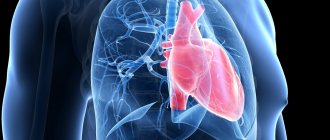The decompensated stage of a chronic disease is considered final. The body's compensatory mechanism is capable of coping with simple functional disorders; a moderately severe condition is compensated with side effects. Decompensation means a complete lack of reserves to compensate for the harm caused by the disease. Without radical medical intervention, the prognosis is extremely unfavorable.
Decompensated diabetes mellitus: what is it? This is the last of the three stages of the disease, in which blood glucose levels fail to stabilize. A worn-out body is not able to counteract pathology even under insulin influence. In this condition, complications develop. In the absence of emergency assistance, the potential end of the decompensated stage of diabetes is death.
Stages of the disease preceding decompensation
Before diabetes mellitus passes into the final (third) stage, the disease goes through two stages of development, determined by the severity of the disease:
- Subcompensated stage. Characterized by the patient's unstable condition. The body is working at its limit. When taking medications, it is not possible to change the sugar level to optimal levels or for a long time. Treatment tactics need urgent correction, otherwise the transition of diabetes mellitus to the stage of decompensation is inevitable.
- Compensated stage. The primary stage of the development of the disease, at which sugar levels can be normalized by taking medications. In this case, the compensatory mechanism is in working condition. The risk of complications is low.
This classification of the course of the disease is characteristic not only of diabetes mellitus. Thus, the patient’s condition is assessed for all incurable pathologies.
Symptoms
Pathology exhibits quite a lot of symptoms. There are no specific signs by which the disease can be accurately diagnosed.
Decompensated heart failure is a consequence of other heart diseases, so the clinical picture is quite varied, as some symptoms overlap with others.
The main symptoms of decompensated heart failure:
- Dyspnea. It manifests itself under light loads, but if there is no appropriate treatment, the pathology progresses and is disturbing, even if the person is in a calm state. This occurs due to congestion in the lungs.
- Swelling of the legs and arms. They are explained by impaired outflow of fluid from the body. In this case, the heart muscle is also affected.
- Dry cough.
- Pain or discomfort in the right hypochondrium.
- Ascites is dropsy in the abdominal cavity. At the same time, the stomach and weight of a person increase significantly.
- General weakness, feeling of overwork.
- Cold feet and hands.
- Small amount of urine, rare urge to urinate.
During examination, doctors detect wheezing in the lungs, arrhythmia, and congestive processes. There is an increase in pressure in the jugular vein.
Causes
A decompensated form of the disease can develop due to the fault of the patient himself, due to the incompetence of the attending endocrinologist, or due to external influences. The first category includes the following reasons: neglect of the dietary diet and non-compliance with doctor’s recommendations, self-medication with folk remedies and biological supplements, ignoring prescribed therapy, refusal to use hormonal treatment with insulin (if it is vitally necessary).
Errors in nutrition are one of the main reasons for the transition of diabetes to the stage of decompensation
Medical errors include: incorrectly selected dose of a hormone (insulin), lack of control over the dynamics of therapy. External influences include sudden stressful situations, unfavorable epidemiological conditions, and infectious viral diseases suffered as a result. Detoxification during infection or poisoning is especially dangerous for a diabetic. This condition can cause dehydration (dehydration of the body).
Treatment of decompensation in Moscow with medications
To eliminate the state of decompensation in mental patients, a number of psychoactive substances are used, which are prescribed by a psychiatrist. These drugs belong to different categories of drugs, and they are used depending on the diagnosis and severity of the patient’s condition:
- for depression and low mood, antidepressants are used;
- anxiety and panic disorders, phobias are treated with serotonin reuptake inhibitors and tranquilizers;
- for bipolar disorder, mood stabilizers become the drugs of choice;
- in people with decompensated schizophrenia, antipsychotics are used;
- If tremors or tics are present, anticonvulsants are used.
To speed up recovery from the state of decompensation, restoration of organ function and central nervous system activity, neuro-metabolic and symptomatic therapy is carried out. For this, doctors use anticosidants, hepato-, cardio- and neuroprotectors, vitamin-mineral complexes, and amino acids. If necessary, vasodilators and analgesics are prescribed.
After achieving the first results of drug treatment, a psychotherapist works with patients. Dr. Isaev’s clinic uses the most modern and effective methods of working with patients.
Comparative indicators of diabetes by disease stage
To determine the stage of the disease, indicators from various studies are compared with standards. This helps control the course of the disease. In cases of decompensated diabetes mellitus, the indicators are always high.
Double blood test to determine sugar levels
Determining blood sugar levels is carried out in two stages:
- the usual fasting test;
- glucose load test (blood test two hours after the patient eats or drinks sweet water).
| Indicators | Fasting sugar (mmol/l) | Glucose loading test (mmol/l) |
| Compensation | 4,4–6,1 | 5,5–8 |
| Subcompensation | 6,2–7,7 | 8,1–10 |
| Decompensation | >7,7 | >10 |
Blood for glycosylated (glycated) hemoglobin
A protein found in red blood cells (erythrocytes), or glycosylated hemoglobin, is referred to in medical tests as HbA1C. Formed by inhibition of hemoglobin and glucose. The analysis data records the percentage of substances (the condition is assessed for three months).
If the rate is more than 10%, diabetes with irreversible consequences is diagnosed
Urine test to determine sugar levels
Glycosuria or the level of glucose in the urine in the absence of diabetes and in the compensated stage is zero, the permissible threshold is 0.06–0.083 mmol/l. In the subcompensation stage, the upper limit should not exceed 0.5 mmol/l. A higher rate is defined as decompensated diabetes.
Blood test for triglyceride and cholesterol levels
These indicators are used to assess the risk of developing cardiovascular diseases (including heart attack and stroke).
Men always have higher triglyceride levels than women
Determination of BMI (BMI)
Obesity is an invariable companion of diabetes mellitus. BMI (body mass index) is calculated using a standard formula.
In type 2 diabetes, obesity can be both a cause and a complication of the disease.
Arterial pressure
Diabetics typically have arterial hypertension. Acceptable indicators: with compensation and subcompensation do not exceed 140/90 and 160/100, respectively. Decompensation is characterized by higher digital values. Diagnosed decompensation of diabetes mellitus requires immediate intervention in the treatment process. To save the patient, it is necessary to change the treatment tactics of both the underlying disease and associated complications.
Complications of the last stage
According to the severity and speed of development, complications are classified as acute and chronic. The last type of complications in the decompensated stage is almost always present. These include:
Leg pain due to diabetes
- Atherosclerotic damage to blood vessels by cholesterol growths. Develops as a result of metabolic disorders (in particular, protein and fat). Subsequently provokes hypertension, coronary artery disease (CHD), heart attacks, strokes, and heart failure.
- Diabetic polyneuropathy of the lower extremities (DPN). It is characterized by the death of nerve and muscle fibers due to the effect of glucose on small vessels (microangiopathy) and large arteries (macroangiopathy). With decompensation, diabetic foot syndrome develops. The end result is tissue necrosis and gangrene.
- Diabetic nephropathy. Pathological transformation of vascular tissue of the kidneys into connective tissue. With this complication, kidney filtration decreases. As a result, kidney failure develops.
- Dermatoses. Due to metabolic and blood circulation disorders, the skin does not receive sufficient nutrition. Any infection causes erosions and ulcers on the epidermis. The healing process is extremely complex and lengthy.
- Non-inflammatory damage to the retina (retinopathy). Occurs against the background of vascular disorders. May lead to complete blindness.
- Osteoporosis and diabetic osteoarthropathy. Thinning of bone tissue and joint deformation due to lack of nutrients.
- Psychopathological and neuropsychological abnormalities. They appear as a consequence of depression, increased nervousness and irritability, often characteristic of diabetics.
- Diabetic hepatopathy. Obesity and compaction of liver tissue due to failure of the processes of processing and metabolism of nutrients (proteins, fats, carbohydrates). The final stage is fatty hepatosis and liver failure.
The only way to prevent the spread of gangrene is surgery to amputate the foot.
Acute conditions
If acute complications occur, the patient needs emergency medical care. Otherwise, the possibility of death cannot be ruled out.
- Diabetic crisis. This diagnosis can have two polar manifestations: hypoglycemia (rapid drop in glucose levels) and hyperglycemia (forced jump in sugar due to acute insulin deficiency). If not treated promptly, both conditions can lead to diabetic coma.
- Diabetic ketoacidosis (DKA). A condition in which the level of ketone (acetone) bodies in the blood sharply increases. Develops against the background of stable hyperglycemia (increased blood glucose levels), metabolic disorders, and acetonemia (ketonemia). It is characterized by acute intoxication and, without medical intervention, threatens coma and death.
- Lactic acidosis. It occurs as a reaction to an excess of lactic acid. The complication is dangerous with the development of hyperlactic acidemic coma.
Important! Symptoms of acute complications tend to increase rapidly. In the absence of emergency assistance, death is possible within a few hours.
States of decompensation in psychopathy
The most varied are the symptoms of the state of decompensation in psychopathy. Experts identify three main types of manifestation of this disease:
- neurotic with syndromes of hypochondria, asthenia, obsessive-phobic symptoms, hysteria;
- affective with emotional instability, explosive-dysphoric syndrome and subdepression;
- abnormally personal.
With neurotic asthenia, rapid fatigue, decreased ability to work, and lethargy are noted. A person often has headaches, excessive sweating, tachycardia, problems digesting food, and tearfulness. With hypochondriacal syndrome, the patient convinces himself and others that he has a serious illness. He sees any minor violation as confirmation that he is right, and often uses his real or fictitious illness to manipulate loved ones. The obsessive-phobic type of deviation is expressed in obsessive fears and thoughts, which lead to an irresistible desire to double-check and control actions.
The affective type of decompensation is accompanied by a constant change of states - from laughter to complete withdrawal or aggression; with explosive-dysphoric syndrome, gloominess, anger, high excitability and conflict are observed. Subdepression is characterized by decreased mood, lack of joy, desire for a specific goal, or desire. A person expresses dissatisfaction for any reason, is gloomy and anxious.
The abnormal personality type often occurs in accentuated individuals, and is also present in patients with schizoid and paranoid psychopathy. In this state of decompensation, all pathological character traits become stronger.
Additionally
Decompensated diabetes is dangerous because of its unpredictability. The slightest provocation (diet violation, stress, lack of insulin) can lead to the death of the patient. In order not to bring the disease to its extreme stage, a diabetic must constantly monitor sugar levels and general well-being, visit an endocrinologist in a timely manner, not independently treat the disease using unconventional methods, without the prior approval of a doctor, and follow all recommendations on nutrition and the use of medications. You cannot get rid of diabetes; the patient must learn to coexist with the disease, protecting himself as much as possible from dangerous consequences.
Questions and answers
Is it always necessary to admit a patient with an exacerbation of his mental state to the hospital?
Hospitalization is required if the doctor assesses the condition as serious, and the person’s behavior is aggressive and poses a threat to others. It is also necessary to place the patient in a hospital if the deviation is discovered for the first time. In this case, a selection of drugs with round-the-clock monitoring of their effect is required.
What to do if a person with a mental disorder refuses treatment?
You can call a doctor to your home so that he can assess the person’s condition and decide on further actions.









